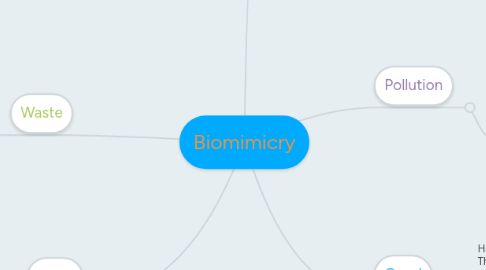
1. Waste
1.1. Waste Management is mimicking the way that natural systems reuse all materials. In nature, there's no such thing as garbage, because every molecule goes through multiple configurations in multiple organisms. When a tree falls, a community of organisms breaks down the tree's chemical compounds into other compounds and individual molecules, which are then used in other organisms. Everything is used, and there is no waste. http://www.asknature.org/product/fc4d0678aa5aba1b8195ec177bcaafce
1.1.1. "The ability to adapt in response to changes in functional demands sets living tissues apart from their engineered counterparts. Muscles grow during development, they remodel in response to use and disuse, and they are able to repair themselves after an injury…The modular design of muscle also facilitates the remodeling and repair of the muscle. The selfhealing properties of muscle emerge from the integration of muscles into a system that allows wound healing and continuous turnover via transport of nutrients and removal of waste products. It is arguably much simpler to grow and repair individual units than having to adapt the entire structure." (Bar-Cohen 2006:50-52) http://www.asknature.org/strategy/2bad51df7f545eb2acca674c89c2dd3b#.UwYVTUJdXDg
2. Sight
2.1. Synthetic corneas mimic the natural cornea of a human eye as they are made of common connective tissue and allow a person’s own cells to regenerate and work in concert with the implant.http://www.asknature.org/product/d39566e991fede55a945111f7791987a
2.1.1. "Kingfishers have specialized eyes and excellent eyesight. The retina of each eye has two fovea. The cone cells have a high proportion of red droplets, which may act as chromatic filters, allowing sight through the surface of the water." (Fowler and Miller 2003: 254) http://www.asknature.org/strategy/82bd508419e4288bbf63bcf16e034a80#.UwYVhEJdXDg
3. Sense
3.1. "In the course of some bibliographical research during the early 1990s, Dr. Armand Cognetta, a dermatologist based in Florida, was surprised to discover in the medical literature a number of confirmed cases in which patients had been found to possess hitherto-unsuspected skin cancers that were detected after their pet dogs (usually for several months before the diagnosis) had been compulsively sniffing the area of skin containing the malignancy. http://www.asknature.org/product/d39566e991fede55a945111f7791987a
3.1.1. "Most insects have socketed hairs (sensory setae) scattered over much of the body which vibrate in response to sounds and may also be sensitive to touch, humidity and light. Nocturnal insects, such as cockroaches, are particularly sensitive to sounds via their setae and have been known to shy away from vibrations issued at 3000 cycles per second--way beyond human hearing capabilities. The setae may also play other roles. Locusts use those on the head, between the antennae, to judge the direction and humidity of the breeze, and climb some eminence for this purpose. Subsequently, they may use the information thus gained to fly to areas of low pressure where rain is likely to induce lusher feeding pasture." (Wootton 1984:48)http://www.asknature.org/strategy/95c8094ba6a0bde79ce3eddef37dc7ef#.UwYU9UJdXDg
4. Pollution
4.1. "[D]eciduous tree leaves, such as those from the maple, aspen, and poplar, suck up far more atmospheric pollutants than previously thought. The study concerns the most abundant class of carbon-based particles in the atmosphere, so-called volatile organic compounds (VOCs)... [A] major source [of VOCs] comes from automobile exhaust, coal burning, and other human activities. Some atmospheric VOCs combine with oxygen to form tiny airborne particles called oxygenated VOCs (oVOCs), which insulate the atmosphere and lead to warming...[Scientists] decided to re-examine how deciduous plants interacted with oVOCs...Plants exposed to oVOCs increased their normal uptake of the compounds, absorbing 40% more than expected." (Berkowitz 2010:1)http://www.asknature.org/strategy/3ca73914c9eff59a39e96fcf5d25dc09#.UwYTI0JdXDg
4.1.1. Self-healing and self-repair is a common theme in biological systems from trees to human skin. The less severe the damage is to an organism, the easier it is for the organism to repair itself and for the repair to be strong and long-lasting. These Engineered Cementitious Composites mimic natural systems in their structure by minimizing damage when it does occur, which leads to the ability to repair themselves quickly and effectively.http://www.asknature.org/product/cd6ff82750db9c9c7490b071e5a6b4d4
5. Good
5.1. Honeybees evolved an efficient hive architecture based on hexagonal structural systems. The designers at Spaldin took heed of this pattern to design this airy, supportive mattress. Good air circulation and support are now available to sleepers, courtesy of beehive-inspired design.http://www.asknature.org/product/722f02c7a952f701c67c8a24ef216e1d
5.1.1. Research on the green birdwing butterfly, Ornithoptera priamus, inspired the researchers to further study the structure of the black area of the butterfly's wings. They found that the overlapping scales of the wings are mainly comprised of adjacent inverse V-type ridges, which can effectively reduce reflection, while at the same time keep transmission at a relatively low level. Because of the almost complete absorption of light, the wings form a model for more efficient solar energy collection.http://www.asknature.org/product/75ba0527a88bd6084ddacf47a54b3eee
